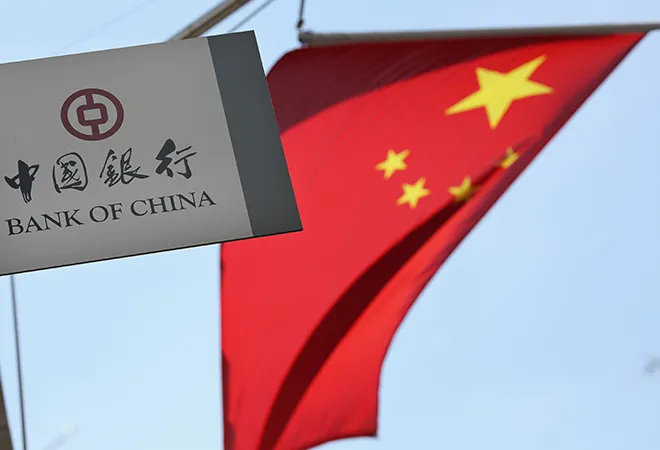 This is the 75th article in the series
This is the 75th article in the series The China Chronicles.
Read all the articles here.
From Argentina to Turkey, and from Indonesia to Mexico, emerging/developing economies have started to be roiled by financial turbulences again. But, one must not lose sight of the biggest problem of them all, one that is on the verge of becoming a huge risk to global growth: China.
Some scholars are of the view that in the past few decades China’s growth has violated certain fundamental laws of economics. Stein’s law holds that if something cannot go on forever, it will stop. However, China’s debt accumulation fails to comply with the Stein’s law, and therefore, China’s debt keeps rising.
Despite the Chinese government’s focus on deleveraging, Chinese corporate, government, and household debts have increased by $23 trillion in the last decade alone, and its debt to GDP ratio has risen by about 100% points, according to Bloomberg. The concern is not the amount of debt accumulated but the speed with which it has been accumulated. History shows that when a country accumulates this much amount of debt so quickly, a crisis follows. According to the People’s Bank of China, in a decade since 2008, the Chinese economy has added about $12 trillion worth of debt.
Stein’s law holds that if something cannot go on forever, it will stop. However, China’s debt accumulation fails to comply with the Stein’s law, and thereby, China’s debt keeps rising.
Post the 2008 financial crisis, China shifted its economic model towards internal sources of growth by lending vast amounts of money towards the construction of new housing, infrastructure and factories. And away from exports. This kind of rebalancing created greater risk of collapse and required even more debt and investment. Owing to this, the government was forced to provide only a moderate amount of stimulus to the economy.
Yet, it seems that the stimulus has never really stopped. Instead, debt has become the motor at the core of Chinese growth. And at some point Stein’s law will assert itself.
To be fair, America has had a debt problem, too. So has Japan. America’s debt to GDP ratio is 105.40%. Japan’s debt to GDP ratio is 250%.
These are large numbers. But the numbers are solid and can be fact-checked. So the debt prices and yields of the two countries reflect the risk premiums investors must receive in holding them in their portfolio.
However, this isn’t the current situation regarding Chinese debt.
Officially, it is a small number: 47.60%. Unofficially, it’s hard to figure out. For a good reason, the government is both the lender and the borrower. One branch of the government lends money to another branch of government.
But there are some unofficial estimates. Like one from the Institute of International Finance (IIF) last year, placing China’s debt to GDP at a whopping 300%!
Credit agencies and financial markets have yet to factor the unofficial debt estimates into the price of Chinese financial assets.
Meanwhile, credit agencies and financial markets have yet to factor the unofficial debt estimates into the price of Chinese financial assets. That’s why China’s debt rating by S&P and Moody’s are very close to those of America and Japan.
| Country |
S&P |
Moody’s |
10-year T-Bond yield |
| China |
A+ |
A1 |
3.37* |
| USA |
AA+ |
Aaa |
3.06 |
| Japan |
A+ |
A1 |
0.10 |
*7-year
Source: Tradineconomics.com (as on 31 November 2018)
Worse, owing to the Chinese government’s role as both lender and borrower, it continues to concentrate rather than disperse risk. And that creates potential of a systematic collapse.
Meanwhile, the dual role of government conflicts contradicts a third role — that of a regulator — the setting of the rules for lenders and borrowers. And it complicates creditor bailouts in case of financial crisis.
This means that the haircut shifted losses from one government branch to another that creates the need for new loans to cover the losses.
The situation could be more severe for China.
The government simultaneously owns banks, pension funds and corporations. Government-owned banks lend money directly to government owned corporations. They usually function as welfare agencies. Banks also lend funds to land developers. They are behind the country’s “investment” bubble — one of the engines of the Chinese economy.
It is surprising that the banking system has remained unscathed, since Beijing — much like other major economies around the world — launched a massive economic stimulus post the financial crisis in 2008, but, unlike other countries who funded their stimulus through government spending, in China, the heavy lifting was done by its banks (see chart above).
However, the only plausible explanation that China continues to hang on is that it continues to utilise large pools of domestic savings and large foreign exchange reserves (over $3 trillion) to head off financial panics.
It is surprising that the banking system has remained unscathed, since Beijing — much like other major economies around the world — launched a massive economic stimulus post the financial crisis in 2008, but, unlike other countries who funded their stimulus through government spending, in China, the heavy lifting was done by its banks.
The problem of the Chinese economy seems to have been born from an economic model that has not evolved, with reforms never really materialising as it should. And with the government’s vices like its grip on the economy, the economic model has started to threaten both Chinese and global economies. International Monetary Fund (IMF) has projected that China’s growth may fall to 6%, the worst in three decades.
Even official Chinese data states that downturn in China has started to hit industrial production and factory orders. Consumers have started to spend less, and private business sentiment has become gloomy.
Growing property price in mainland China has started to cool, with fears mounting over Chinese developers’ debt levels. Chinese developers currently face $55 billion of maturing onshore debt (2019), raising concerns over defaults at a time of economic slowdown and tightening liquidity. Also, property developers have struggled to issue new debt and refinance maturing bonds in 2018 as the Chinese government has attempted to control the runaway credit-fueled growth that has helped power the sector in recent years.
The problem is graver than it looks as China’s $134 billion debt maturity wave can trigger even more defaults in the upcoming year. Above all, how the Chinese economy copes with it remains to be seen.
The reality is that any ambiguity in China’s economic performance would have a seismic effect on the major financial centres across the globe, as it would lead to a significant weakening of the Renminbi. In fact, China might itself engineer a depreciation of its currency to promote its exports, and cushion the inevitable fall in domestic demand, particularly its investment component.
Such a scenario would have a tsunami-like impact on global currencies. Other major Asian countries would respond by pursuing their own devaluations to maintain their competitiveness, and Europe and the United States would experience sharp deflation as their currencies strengthened in kind.
The views expressed above belong to the author(s). ORF research and analyses now available on Telegram! Click here to access our curated content — blogs, longforms and interviews.



 This is the 75th article in the series The China Chronicles.
Read all the articles
This is the 75th article in the series The China Chronicles.
Read all the articles  PREV
PREV


